Echoing
2024.11.11-2025.05.31
- Location:Dunhuang Contemporary Art Museum
- Artist:
The exhibition “Echoing” presents Yang Zhenzhong’s artist-in-residency program at Dunhuang, commissioned by the Shanghai Dunhuang Contemporary Art Museum. During this residency, Yang Zhenzhong visited not only acclaimed natural, historical, and cultural heritage sites such as Dunhuang’s Mogao Grottoes, the Western Thousand Buddha Caves, Echoing-Sand Mountain, the Yumen Pass and the Yadan Mountains, but also Asia’s largest photovoltaic energy plant – the Shouhang Hi-Tech Dunhuang Molten Salt Tower Photovoltaic Power Plant, which is hailed as a new landmark for contemporary Dunhuang. And the scattered natural villages and small local museums, such as Qinjiawan Village, Zhangjia Village, Dunhuang Artisan Museum and Farming Museum, were also part of the artist’s research scope.
Dunhuang, known for being the most ambitious and systematized visual aesthetic denominator in China over the centuries, presenting society, history, humanities, art, and religion, challenges any artist who are “assigned a project” on this subject. After nearly three months of traveling between Shanghai and Dunhuang, Yang Zhenzhong eventually chose to observe and sketch Dunhuang with the command of his artistic language. Through his usual witty and allusive gestures, Yang Zhenzhong transmutes and repurposes from juxtaposing Dunhuang’s “majesty” with everyday life “insignificance”, showing three works in this exhibition, completed at various times, contexts, and backgrounds, as the artist’s profiling of collective portraits in everyday life that are ordinary yet immense. These works provide Dunhuang with a more direct and specific meaning through video, sound, and installation, showcasing contemporary art’s innovative thinking and artistic exploration of traditional culture.
The two-channel video Echoing is the first work that meets the viewer’s gaze and is a piece Yang Zhenzhong produced specifically for the residency program. Unlike the common horizontal format of video art, the two giant vertical screens signal the new image era informed by smartphones: a device that has become the indispensable electronic artificial organ attached to the human body. While the massive visual explosion triggered by the proliferation of short-form video culture has blurred borders of cultural identity and morality, it also offered us a visual dividend. Most of the material in the left screen was shot at the Echoing-Sand Mountain scenic site, where the artist adopted documentary filming techniques to inadvertently record tourists’ odd and bizarre postures in the desert – tourists wearing various styles of clothing from Dunhuang murals, posing as the iconic figures on the murals under the photographer’s guidance. The other screen slowly unfolds images from Dunhuang’s cave paintings in the manner of a traditional Chinese handscroll, scanning details of people, architecture, and landscapes. Subtle resonance and contrast between the two screens in rhythm and content instantly form an underlying alliance. In the context of the industrialization of culture and tourism, cultural heritage sites, including Dunhuang, have been transformed into iconic social landscapes with pragmatic attributes, and “mimicking” has become the easiest way for ordinary people to understand Dunhuang as “a sample of the sacred.”
Nod in Silence, an interactive sound installation at the center of the gallery is an augmented version of Yang Zhenzhong’s 2006 work I Have a Dream, delivering artistic meaning in the context of this exhibition. The artist set up a raised lecture platform where the spectator would have to reach its top through the steps, and there the microphone would capture their voice. Compared to the rudimentary voice alteration software used for his 2006 piece, Nod in Silence employs AI technology (ChatGPT and RVC modeling), which transforms the spectators’ voices into ten real-life sources sampled from various age groups and genders and synchronized with negligible latency, creating a resonant and artificial group reverberation. It generates an overwhelming, unseen but intensely perceptible force rushes over, reverberating and wrapping itself around everyone in the gallery. At that moment, the content of what is spoken on stage would have been “dissolved” and replaced by artificially generated collective voices with ritualistic repetitions, and the sound coming from above no longer matters.
The exhibition concludes with the installation Tools, an extension and variation of Yang Zhenzhong’s 2020 series Exposure. Yang shifted his focus on the subject of labor in Exposure and began to explore the social relations of production, which has been central to his art practice in recent years, only that the material for Tools has been replaced with sturdy but inexpensive production tools from the rigid and fragile marbles. The component of labor, an easily overlooked theme in Yang Zhengzhong’s work, is just as prevalent in Dunhuang, because the general public is less likely to associate it with; however, compared to the magnificent and sophisticated depictions of the Buddha’s biographies, Jataka, sutra transformations, and historical contexts, the labor and production scenes we have seen often seem gritty and plain. Fifty-four sets of installations consist of various labor tools collected from local villages and online second-hand shops, are arranged orderly and placed atop metal pedestals. Through the integration of 3D carving technology and hand polishing by artisans from Dongyang, Zhejiang Province, these used objects aged with traces of the laboring class and its relations of production, are given new imaginative dimension and aesthetic significance. The spectator’s close-up view of the installation projects sympathy and empathy for the absent protagonists who should have been present under this deliberately created setting of the collective unconscious.
–Tao Hanchen


